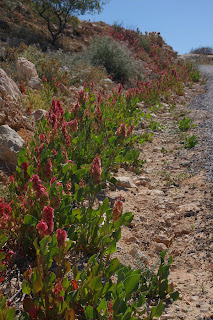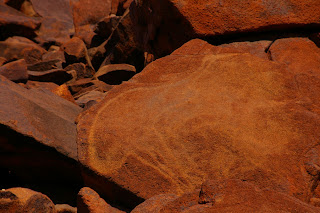Monkey Mia - 7th September, 2007
This morning we got up early and made the 20 minute drive to Monkey Mia to see the dolphin feeding take place which we w ere told happens between 8am and 1 pm. It is a free event but they charge $6 per person to go into the Monkey Mia Reserve which gives you a pass to park your car in the car park and apparently return the next day if you like. When we got there lots of people were already lined up along the shore or in the shallows and there were dolphins and some rangers there also. After a while we were asked to step back out of the water and someone brought buckets of fish down ready to feed the waiting dolphins. They actually have specific buckets for particular dolphins since they know what they like to eat and also then can control how much they get hand fed each day in order to ensure that they still go out hunting and teach their young to catch food also. There are usually four rangers there to fe
ere told happens between 8am and 1 pm. It is a free event but they charge $6 per person to go into the Monkey Mia Reserve which gives you a pass to park your car in the car park and apparently return the next day if you like. When we got there lots of people were already lined up along the shore or in the shallows and there were dolphins and some rangers there also. After a while we were asked to step back out of the water and someone brought buckets of fish down ready to feed the waiting dolphins. They actually have specific buckets for particular dolphins since they know what they like to eat and also then can control how much they get hand fed each day in order to ensure that they still go out hunting and teach their young to catch food also. There are usually four rangers there to fe ed the dolphins and each chooses someone from the crowd to have a turn. Unfortunately they only give them one or two fish each time and then the last fish when they have signalled the others that they have done so and then they wash out their buckets and ask everyone to go away from the edge so the dolphins know it is over and there will be no more. They did this 3 times this morning, less than an hour apart, the timing being dictated by the dolphins, and we were there for each feeding but didn’t get to have a turn. Drat! I got some good photos of the dolphins though and they came up very close. They use their nose to push the legs of the ranger like a dog nudges when it wants something; it’s funny watching the ranger’s legs buckle & hear he
ed the dolphins and each chooses someone from the crowd to have a turn. Unfortunately they only give them one or two fish each time and then the last fish when they have signalled the others that they have done so and then they wash out their buckets and ask everyone to go away from the edge so the dolphins know it is over and there will be no more. They did this 3 times this morning, less than an hour apart, the timing being dictated by the dolphins, and we were there for each feeding but didn’t get to have a turn. Drat! I got some good photos of the dolphins though and they came up very close. They use their nose to push the legs of the ranger like a dog nudges when it wants something; it’s funny watching the ranger’s legs buckle & hear he r say, “You’re going to knock me over. You just have to wait.” They only feed the females and they bring their calves in with them. The calves are amusing; just like kids mucking around nearby, splashing and darting away! In fact one of them came up to where its mum was being fed and, with its blowhole under water, started blowing bubbles. It sounded a bit like blurting! Apparently they do this if they are happy. It was really funny.
r say, “You’re going to knock me over. You just have to wait.” They only feed the females and they bring their calves in with them. The calves are amusing; just like kids mucking around nearby, splashing and darting away! In fact one of them came up to where its mum was being fed and, with its blowhole under water, started blowing bubbles. It sounded a bit like blurting! Apparently they do this if they are happy. It was really funny.
We had breakfast at the resort restaurant after the first feeding then had a look around between times until 10:45am when we had to be on the jetty for our catamaran cruise on Aristocat 2. We were taken to the black pearl farm, Blue Lagoon, first where they explained to us about how they farm the pearls and what makes them black pearls. It is not the c olour of the pearl so much as the black lip on the pearl shell. The pearls they produce are a darker colour because of the colour of the shell but not really what you would call black. What was very interesting is the amount of money the pearl technicians earn per day; about $1,500 a day and up to $10,000 a day for the really good ones. They have 45 seconds to open the shell and place the nuclide into the pearl oyster before it starts to react and then it is unable to be used and it is a delicate operation which requires a lot of skill. So, kiddies, become an expert pearl technician and you will be laughing all the way to the bank!
olour of the pearl so much as the black lip on the pearl shell. The pearls they produce are a darker colour because of the colour of the shell but not really what you would call black. What was very interesting is the amount of money the pearl technicians earn per day; about $1,500 a day and up to $10,000 a day for the really good ones. They have 45 seconds to open the shell and place the nuclide into the pearl oyster before it starts to react and then it is unable to be used and it is a delicate operation which requires a lot of skill. So, kiddies, become an expert pearl technician and you will be laughing all the way to the bank!
Next we headed out to sea to the seagrass meadows where we hoped to see some dugongs feeding and we  did! They graze the seagrass until they need to come up for air and when they do we get to see them. The first one we sighted confirmed the belief that the mermaid stories have come from dugong sightings since, especially from a distance, do look like a mermaid. The colour is similar to human flesh and the tail going down after is just the same shape as what we traditionally know as a mermaid’s tail. We saw quite a few of them and got fairly close but they are very quick when they surface to breathe and so not many good photos. Still, it was fantastic to see them for real; we went out prepared not to spot any but were pleasantly surprised. We also saw a rather big loggerhead turtle which swam right towards us for a while. Toward the end of the cruise, they put down the boom net and the very keen kids on board got in and had a ride in the wake. The water was cold when we waded in to feed the dolphins and the wind was cold on board so there was no way any adult would submerse themselves in it but you know kids, no sense, no feeling! And they had a great time by the looks of them anyway. Aah, to be young again! It was a good cruise and, again, I didn’t get seasick and this time it did become rougher so I was able to enjoy the whole experience. Hooray!
did! They graze the seagrass until they need to come up for air and when they do we get to see them. The first one we sighted confirmed the belief that the mermaid stories have come from dugong sightings since, especially from a distance, do look like a mermaid. The colour is similar to human flesh and the tail going down after is just the same shape as what we traditionally know as a mermaid’s tail. We saw quite a few of them and got fairly close but they are very quick when they surface to breathe and so not many good photos. Still, it was fantastic to see them for real; we went out prepared not to spot any but were pleasantly surprised. We also saw a rather big loggerhead turtle which swam right towards us for a while. Toward the end of the cruise, they put down the boom net and the very keen kids on board got in and had a ride in the wake. The water was cold when we waded in to feed the dolphins and the wind was cold on board so there was no way any adult would submerse themselves in it but you know kids, no sense, no feeling! And they had a great time by the looks of them anyway. Aah, to be young again! It was a good cruise and, again, I didn’t get seasick and this time it did become rougher so I was able to enjoy the whole experience. Hooray! 
BTW, Fin had a chat to the driver of the Gold Bus as they were at the Monkey Mia Reserve to see the dolphins being fed. He told him that they were going off to somewhere else today and then would be heading to Geraldton the next day followed by Perth for a day or two before they fly off home to New Zealand. So now we know where they will be and will finally shake them! LOL!


























